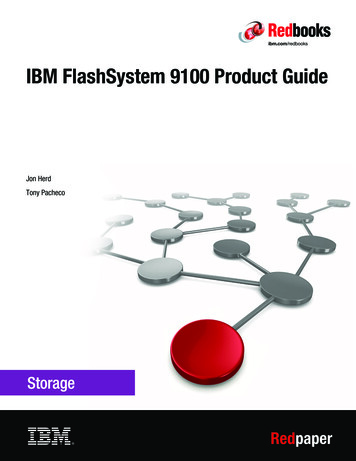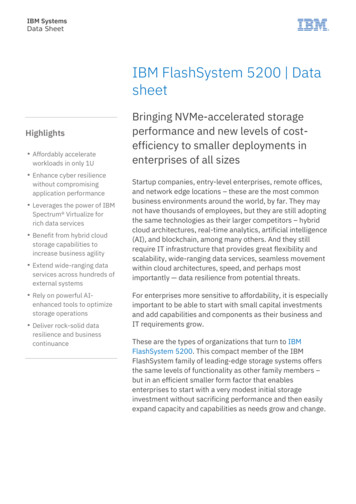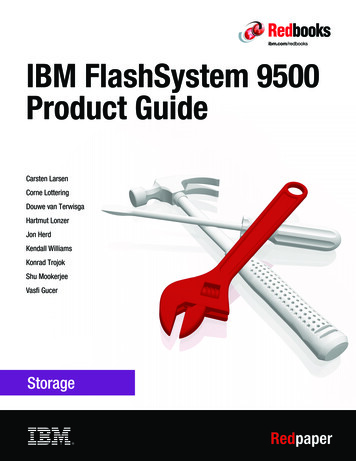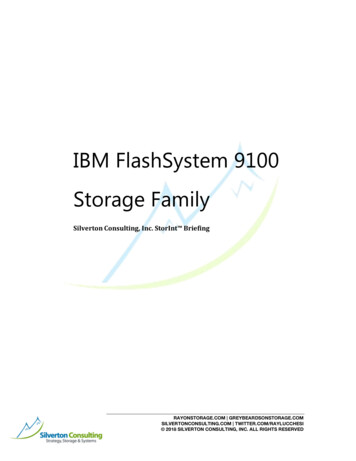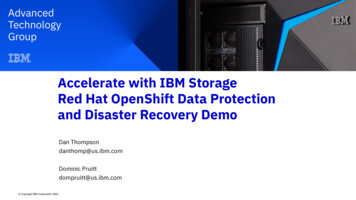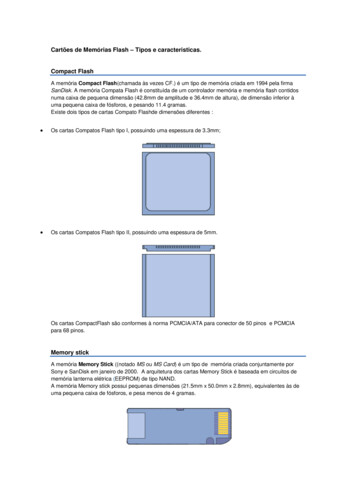
Transcription
IBM FlashSystem all-flash storage and Oracle Database 12cIncreasing Oracle Database performance, efficiency, and valueNearly a decade long, proven trackrecord of accelerating Oracle DatabaseperformanceMicrosecond-scale storage latencydelivered by IBM FlashSystem arraysbenefit the Oracle Database in manyways, improving redo log performance,complex sorts, and other processesRich set of data managementcapabilities and storage servicesprovided by IBM FlashSystem V9000complement Oracle ASM and OracleRAC featuresLower cost of Oracle Database datastorage through increased data agility,dynamic data management, andoptimized efficiencyBuilding business value through innovationToday, IT infrastructure is fully entwined with basic business operations, whichmeans that crucial business questions become information technology questions.What is it worth to stay ahead of the competition? What is a better online customerexperience worth to the bottom line? What advantages are gained by makingfaster, more informed business decisions? Can we afford not to have the bestpossible fraud protection and data security? When you answer these businesscritical questions in terms of IT infrastructure, and recognize the crucial rolestorage plays in the right answers, then the value of IBM FlashSystem becomesvery clear.IBM FlashSystem storageThe IBM FlashSystem family of all-flash storage arrays brings a long andsuccessful history of accelerating Oracle Databases. The extreme performance,IBM MicroLatency , macro-efficiency, and enterprise-grade reliability offeredby IBM FlashSystem arrays make an excellent fit with the current and futurestorage needs of Oracle Database applications. In addition to platforms that focusexclusively on providing the lowest possible latency with excellent cost-efficiency,IBM FlashSystem storage provides a wide range of enterprise-grade management
and feature-rich storage services. IBM FlashSystem platforms and configurationshave been exhaustively tested and benchmarked against the full spectrumof Oracle Database versions, including years of successful deploymentwith Oracle Automatic Storage Management (Oracle ASM) and Oracle RealApplication Clusters (Oracle RAC). IBM FlashSystem solutions provide multipleoptions for Oracle Database users seeking to address high velocity applicationrequirements, increase system efficiency, and lower IT costs.The IBM FlashSystem family includes IBM FlashSystem 900 and IBMFlashSystem V9000 arrays. Powered by IBM FlashCore technology, IBMFlashSystem 900 delivers the extreme performance, enterprise reliability,and operational efficiencies required to gain competitive advantage in today’sdynamic marketplace.Adding to these capabilities, FlashSystem V9000 offers the advantages ofsoftware defined storage at the speed of flash. These all-flash storage systemsdeliver the full capabilities of FlashCore technology’s hardware acceleratedarchitecture, MicroLatency modules, and advanced flash management. Thosecapabilities are coupled with a rich set of features found in only the mostadvanced enterprise storage solutions, including IBM Real-time Compression ,external storage virtualization, dynamic tiering, thin provisioning, snapshots,cloning, replication, data copy services, and high-availability configurations.The IBM and Oracle allianceSince 1986, Oracle and IBM have been providing customers with compellingjoint solutions, combining Oracle’s technology and application software withIBM’s complementary hardware, software and services solutions. More than100,000 joint customers benefit from the strength and stability of the Oracleand IBM alliance, which offers technology, applications, services, and hardwaresolutions that mitigate risk, boost efficiency, and lower total cost of ownership.IBM is a Diamond Partner in the Oracle Partner Network, delivering the provencombination of industry insight, extensive real-world Oracle applicationsexperience, deep technical skills and high performance servers and storageto create a complete business solution with a defined return on investment.From application selection, purchase and implementation to upgrade andmaintenance, we help organizations reduce the total cost of ownership and thecomplexity of managing their current and future applications environment whilebuilding a solid base for business growth.Oracle Database 12cOracle Database 12c, the latest generation of Oracle Database, has a majorfocus on cloud and enables customers to make more efficient use of theirIT resources. This latest generation Oracle Database has a new multitenantarchitecture, and includes several enhancements and new features for: Consolidating multiple databases into multitenant containers Automatically optimizing data storage Providing continuous access with high availability features Securing enterprise data with a comprehensive defense-in-depth strategy Simplifying in-database analysis of Big Data
Multitenant architectureOracle Multitenant delivers an architecture that simplifies consolidation anddelivers the high density of schema based consolidation, without requiringchanges to existing applications. It’s an option of Oracle Database 12c thatoffers the benefits of managing many databases as one, yet retains the isolationand resource control of separate databases. In this architecture, a singlemultitenant container database can host many ‘pluggable’ databases. Eachdatabase consolidated or ‘plugged in’ to a multitenant container looks and feelsto applications exactly the same as a standalone non-container Oracle Database.Administrators can control the prioritization of available resources betweenconsolidated databases thereby enabling dynamic policy based resourcemanagement.Database In-MemoryOracle Database In-Memory uses a new dual-format in-memory architecture thatallows simultaneous row and column format representations of data availableat all times. Using the dual-format architecture, Oracle Database In-Memoryaccelerates both Data Warehouses and mixed workload OLTP databases. Anyexisting applications compatible with Oracle Database 12c can easily startutilizing Oracle Database In-Memory without requiring any changes.Automatic Data OptimizationThe pattern of usage of rows stored in database tables and partitions changesover time. In addition to the age of data, its level of activity is also important. It’scommon for rows to be continuously updated over time; therefore a combinationof age and activity is required to determine the usage pattern of table rows. NewAutomatic Data Optimization features in Oracle Database 12c can be used toimplement an automated Information Lifecycle Management strategy using aHeat Map and server managed storage policies that enable smart compressionand storage tiering.High availabilityBasic high availability architectures using redundant resources can provecostly and fall short of availability service level expectations due to technologicallimitations, complex integration requirements, and an inability to provideavailability through planned maintenance. Oracle Database 12c goes beyond thelimitations of basic high availability and in conjunction with hardware featuressuch as provided by IBM storage devices and servers, offers customers a set ofbest practice blueprints that can be deployed at minimal cost and address thecommon causes of unforeseen and planned downtime.
Reducing planned downtimePlanned downtime for essential maintenance such as hardware upgrades,software upgrades and patching are part and parcel of every IT operation. OracleDatabase 12c offers a number of solutions to help customers reduce the amountof planned downtime required for maintenance activities, including: Hardware Maintenance and Migration Operations to Oracle Database 12cinfrastructure can be performed without taking users offline. Online Patching of database software can be applied to server nodes in a‘rolling’ manner using Oracle RAC. Users are simply migrated from one serverto another; the server is quiesced from the cluster, patched, and then putback online. Rolling Database Upgrades using Oracle Active Data Guard enablesupgrading of a standby database, testing of the upgraded environment andthen switching users to the new environment, without any downtime. Online Redefinition can reduce maintenance downtime by allowing changesto a table structure while continuing to support an online production system. Edition Based Redefinition enables online application upgrades. With editionbased redefinition, changes to program code can be made in the privacy ofa new edition within the database, separated from the current productionedition. Data Guard Far Sync provides zero data loss protection for a productiondatabase by maintaining a synchronized standby database located at anydistance from the primary location. Global Data Services provides inter-region and intra-region load balancingacross Active Data Guard and Golden Gate replicated databases. It effectivelyprovides Real Application Cluster failover and load balancing capabilities toActive Data Guard and Golden Gate distributed databases.Simplifying analysis of Big DataOracle Database 12c fully supports a wide range of Business Intelligence toolsthat take advantage of optimizations including; advanced indexing operations,Oracle OLAP aggregations, automatic star query transformations, partitioningpruning and parallelized database operations.By providing a comprehensive set of integration tools, customers can use theirexisting Oracle resources and skills to bring together big data sources into theirdata warehouse. With this, customers can add to the existing Oracle Database12c features, the ability to better analyze data throughout the enterprise.The power of preferred readsOne of the most compelling use cases for IBM FlashSystem all-flash storage isto speed up an Oracle Database via the preferred read process. The concept ofthe preferred read is not a new idea, but it’s very easily implemented leveragingOracle ASM volume management. The concept is to do all reads from the fasteststorage while mirroring writes between a fast device and a slow device. Initially,the preferred read concept was designed for global mirroring or site-specificstorage in order to avoid higher-latency site connections. By restricting datareads to the local storage, databases would be able to service requests atnominal read speeds while writes were the only communication needed totraverse the long haul site link.
This concept of preferred reads can be adapted for use with local storage withdiffering performance characteristics. Because the concept of preferred reads isto read from a lower latency mirror, the strategy of preferring the reads from IBMFlashSystem storage mirrored to an existing disk array can be employed—withgreat read performance benefits to applications and the enterprises dependingon them. This allows IBM FlashSystem arrays to be deployed with additionalredundancy by mirroring to an existing disk array, which may avoid the cost ofdeploying multiple IBM FlashSystem units. Many shops have a large investment inhardware, software, and procedures for backup and disaster recovery. Expectingthese shops to do a rip and replace to implement IBM FlashSystem technology isnot realistic.The combination of Oracle ASM preferred reads and IBM FlashSystem storageoffers significantly greater customer value across multiple dimensions thantraditional storage architectures. More database transactions with lower latencyand higher overall throughput result from the use of preferred reads with IBMFlashSystem storage and existing disk-based storage systems. With higherdatabase performance driven by FlashSystem storage, fundamental costs perdatabase transaction are reduced. It all adds up to a win for enterprises looking togain competitive advantage while at the same time lowering overall IT costs.IBM FlashSystem V9000IBM FlashSystem V9000 is designed to accelerate all types of applicationsand infrastructures, but it is most often deployed to support high-performancedatabase applications such as those based on Oracle Database, and to replaceexisting Tier 1 storage constrained by slow disk drives. By accelerating multipleworkloads—both physical and virtual—IBM FlashSystem V9000 can helporganizations reduce costs, increase revenue, and improve customer satisfaction.IBM FlashSystem V9000 can function as a feature-rich, software-defined storagelayer that virtualizes and extends the functionality of all managed storage. In thiscapacity, it acts as the virtualization layer between the host and other externalstorage systems, providing flexibility and extending functionality to the virtualizedexternal storage capacity. Up to 32 PB of external storage can be managed bya single IBM FlashSystem V9000 array, and because the storage is virtualized,volumes can be non-disruptively moved between external and internal storagecapacity. This functionality enables very agile integration into existing storageenvironments with seamless data migration between FlashSystem V9000 andlegacy storage systems.FlashSystem V9000 can take the place of multiple racks of hard disk drives—lowering power, space, and cooling costs. Plus, it can increase server efficiency,which can further cut power and cooling costs and reduce software licensingexpenses. When using Real-time Compression for active data sets, V9000 canincrease the effective capacity of your flash storage up to five times.
To make your entire storage environment easier to manage while preserving yourinvestments in legacy storage, FlashSystem V9000 offers: Storage virtualization technology: Helps you manage other IBM or third-partystorage arrays. IBM FlashSystem V9000 software-defined storage capabilitiesslow storage growth and lower infrastructure costs through powerful featuressuch as end-to-end storage virtualization, real-time data compression, andapplication aware snapshots. Scalable performance: Allows flash capacity to be added (scaled up)to support multiple applications, the virtualized system to be expanded(scaled out) to support higher IOPS and bandwidth, or the solution to besimultaneously scaled up and out to improve capacity, IOPS, and bandwidthwhile maintaining MicroLatency. Agile integration: Enables enterprises to tailor storage deploymentarchitectures to specific workloads, including data access that bypasses thestorage virtualization layer for low latency data access, data compressionusing Real-time Compression, and data replication to disaster recovery sites.IBM FlashSystem 900Easy to deploy and manage, IBM FlashSystem 900 is designed to acceleratethe applications that drive business – like those using an Oracle Database.Advanced flash management features include Variable Stripe RAID technology,IBM-engineered error correction codes, overprovisioning capabilities, ultrafast write buffers, and hardware-based data offloads. Features also includeproprietary garbage collection, relocation, and block-picking algorithms that notonly increase flash endurance, but also increase performance and decreaselatency.In addition, IBM FlashSystem 900 is composed of up to 12 MicroLatencymodules that provide extremely high storage capacities. In fact, IBMFlashSystem 900 can scale usable capacity from as low as 2 TB to as much as57 TB in a single system. The MicroLatency modules also support an offloadAES-256 encryption engine, high-speed internal interfaces, and full hot-swapand storage capacity scale-out capabilities, enabling organizations to achievelower cost per capacity with the same enterprise reliability.Sizing and capacity planning Oracle Database with IBM FlashSystemtechnologyWorking together, IBM and Oracle have developed a capacity-estimationcapability to aid in designing optimal configurations, including using IBMFlashSystem storage for each specific Oracle Database customer environment.A detailed sizing estimate customized for your environment should be obtainedfrom the IBM Techline ISV Solutions Sizing Team, accessible through your IBMor IBM Business Partner representative. You can download a questionnaire tostart the sizing process er/techline/FAQ00000750
For more informationTo explore other joint solutions from IBM and Oracle, please contact an IBMsales representative at 1-866-426-9989, or visit us at:ibm.com/solutions/oracleibmandoracle.comFor more information about IBM FlashSystem storage, visit:ibm.com/systems/storage/flashFor more information about IBM FlashSystem and Oracle Databaseperformance, access the documents posted at:ibm.com/common/ssi/cgi-bin/ssialias?infotype SA&subtype WH&htmlfid TSW03285USEN&attachment TSW03285USEN.PDF&appname STGE TS ZUMYEN or more information about Oracle Database 12c, /index.html
Copyright IBM Corporation 2015IBM Systems and Technology GroupRoute 100Somers, New York 10589Produced in the United States of AmericaNovember 2015All Rights ReservedCopyright 2015 Oracle All rights reserved.Oracle and Java are registered trademarks of Oracle and/or its affiliates.Oracle Corporation500 Oracle ParkwayRedwood Shores, CA 94065IBM, the IBM logo, FlashCore, FlashSystem, MicroLatency, andReal-time Compression are trademarks or registered trademarksof International Business Machines Corp., registered in manyjurisdictions worldwide. Other product and service names mightbe trademarks of IBM or other companies. A current list of IBMtrademarks is available on the web at:ibm.com/legal/copytrade.shtml.THE INFORMATION IN THIS DOCUMENT IS PROVIDED“AS IS” WITHOUT ANY WARRANTY, EXPRESS ORIMPLIED, INCLUDING WITHOUT ANY WARRANTIESOF MERCHANTABILITY, FITNESS FOR A PARTICULARPURPOSE AND ANY WARRANTY OR CONDITION OFNON-INFRINGEMENT. IBM products are warranted accordingto the terms and conditions of the agreements under which theyare provided.This document is current as of the initial date of publication andmay be changed by IBM at any time. Not all offerings are available in every country in which IBM operates.ORD03055-USEN-00
Oracle Database In-Memory uses a new dual-format in-memory architecture that allows simultaneous row and column format representations of data available . hardware, software, and procedures for backup and disaster recovery. Expecting these shops to do a rip and replace to implement IBM FlashSystem technology is

